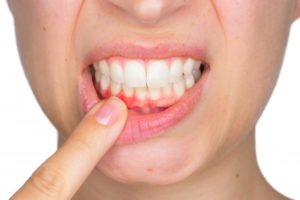
You know that sleepy feeling you get after eating a big meal? Some people refer to it as the “itis.” While passing right out on the couch isn’t necessarily a big deal, it can spell trouble when it comes to your oral health.
Look no further than gingivitis and periodontitis. Both are stages of gum disease, but it is helpful to know the differences if your dentist references them.
Read on to learn the details of each problem for your gums as well as how to tell if you have them and how you can prevent gum disease.
What is Gingivitis?
Gingivitis is gum inflammation and usually precedes periodontitis. In the early stages, plaque accumulates between the teeth. The gums become inflamed and easily bleed during tooth brushing.
Though the gums may be irritated, the teeth are still firmly planted. No irreversible bone damage has occurred, as gingivitis is the mildest form of gum disease.
For patients diagnosed with gingivitis, it is not all doom and gloom. Not all gingivitis progresses to periodontitis. The major point is that gingivitis is reversible, while periodontitis is not.
What is Periodontitis?
Periodontitis is inflammation of the surrounding hard tissues of the teeth. When it develops, the inner layer of the gum and bone pull away from the teeth and form pockets. The immune system’s fight to save your gums is not an easy one.
At this advanced stage of gum disease, the teeth are no longer firmly anchored in place. They become loose and tooth loss often follows.
What are the Signs of Gingivitis and Periodontitis?
Key signs of gingivitis are your gums being red and swollen, plus they easily bleed when you brush your teeth. You might also notice bad breath that doesn’t seem to go away, even when you brush or chew mint gum.
Symptoms of periodontitis include prolonged gum issues (red, swollen, bleeding), pain when chewing, poor tooth alignment, persistent bad breath, receding gums, and clear pockets between teeth and gums.
How Can You Prevent Gingivitis and Periodontitis?
Gingivitis is a clear warning sign from your teeth and gums that you must be more proactive about your oral health. Good oral hygiene habits like brushing twice a day, regular dental checkups, daily flossing, and using mouthwash can help prevent and reverse gingivitis. If you suspect you may have gingivitis, you need to see your dentist.
Needless to say, if you suspect you may have periodontitis, the sooner you can see your dentist, the better. While these conditions might sound scary, they are treatable – if you catch periodontitis soon enough – and your dentist is more than qualified to help you get your oral health back on track.
About the Author
Dr. Louis Olberding employs a wide spectrum of techniques that have been fine-tuned through years of continuing education, training, and experience. Earning his DDS from the University of Nebraska Medical Center College of Dentistry, Dr. Olberding is one of only two dentists in Nebraska to hold the prestigious position of Spear Visiting Faculty member. If you suspect you may have gum disease, Dr. Olberding can identify and target problem areas so he can design the best treatment plan with periodontal therapy. Visit his website or call (402) 488-2325 to schedule an appointment or get answers to any questions you might have.
